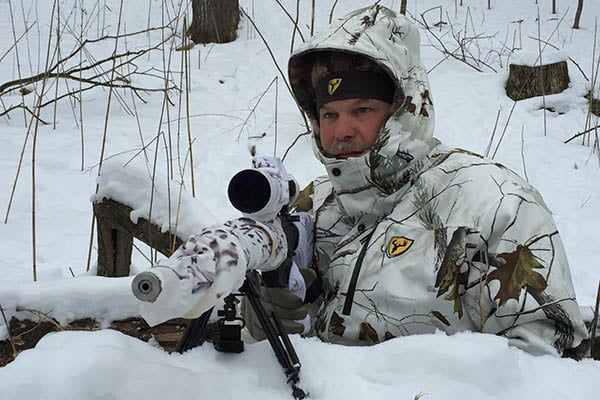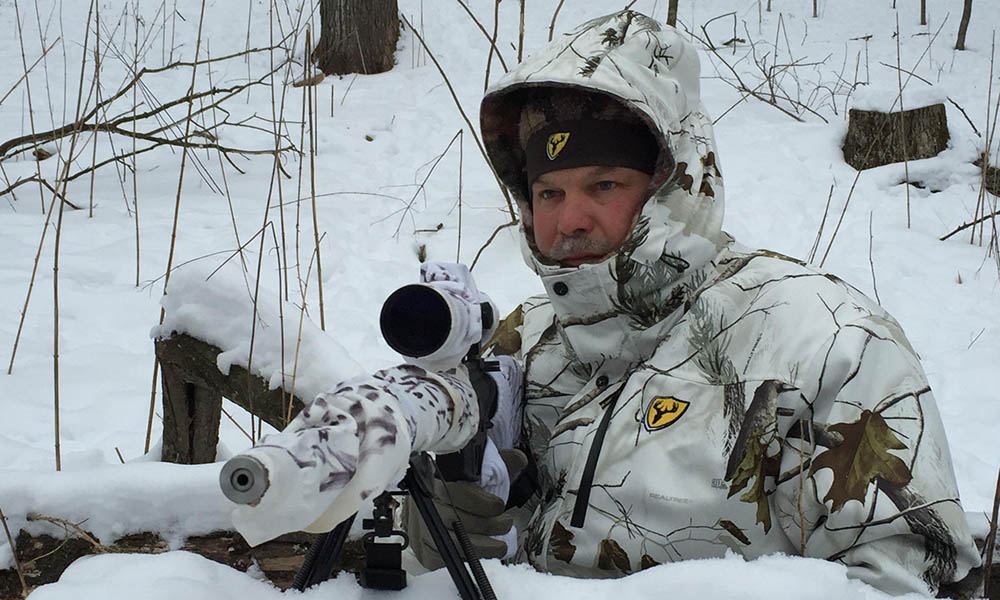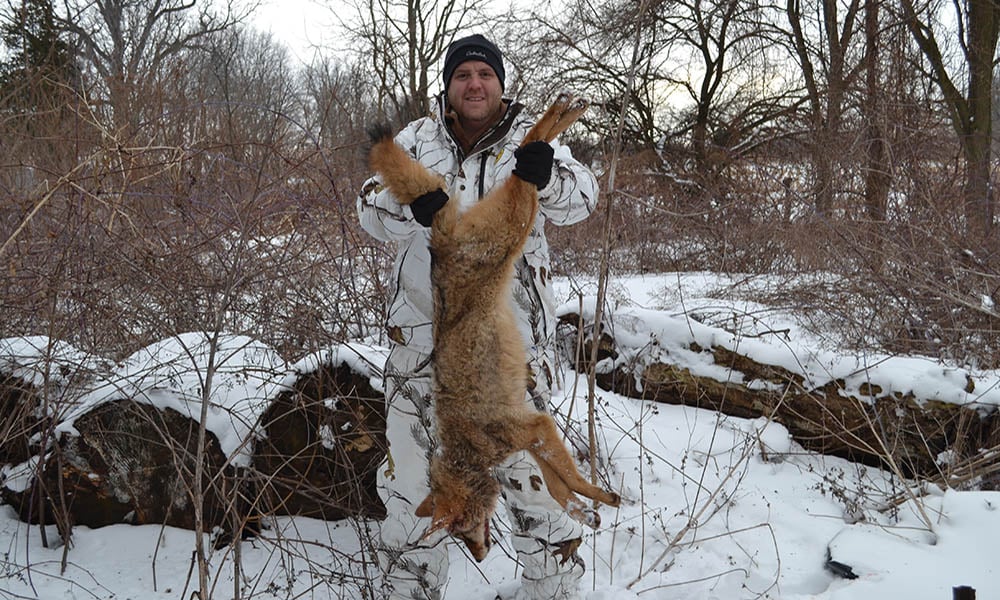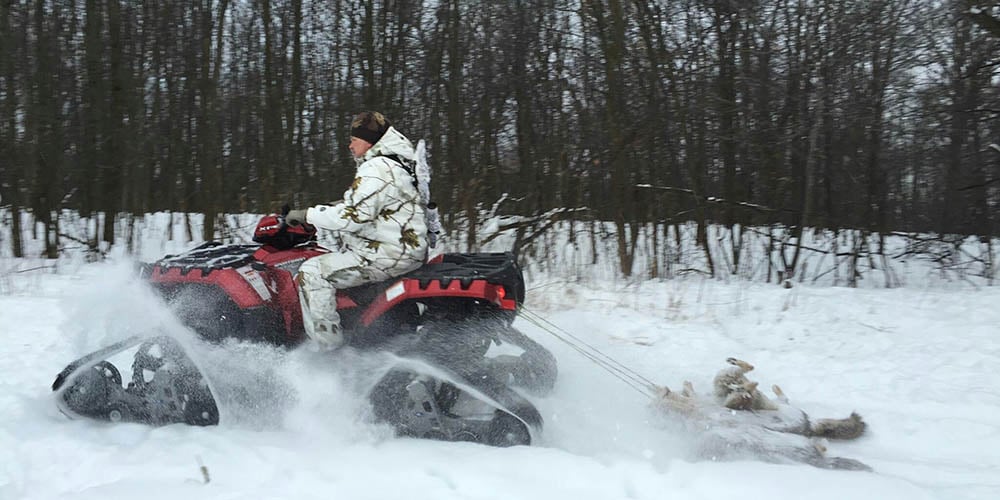
Last Updated on
By Jason Herbert And Scott Shultz for ScentBlocker
“Whaaaaa….Whaaa…..WHHHAA!” The rabbit-in-distress call echoed through the frozen woods.
I had no sooner finished my first calling sequence when I heard, “BOOM!… BOOM!…” My hunting buddy Jon was shooting at something. As I turned, I caught, out of the corner of my eye – about 80 yards out – a giant coyote doing flips and flopping all over the ground. Wow I thought, That didn’t take long…
Although this particular hunt didn’t last too long, predator hunting is typically a time-intensive hobby that requires a perfect setup and the proper gear.
The first thing to understand when trying to successfully hunt predators is their natural tendencies. The animal’s instinct is to use their eyes, ears and nose to check for safety. They will always try to get well enough downwind to scent check what’s going on before committing. So, the trick to predator hunting is to get close enough to where the animal might be while being able to get a shot at it when it tries to position itself downwind. Basically be there when it’s trying to get downwind of the call, or bait site, or whatever. Instinctively these animals are programmed to grab a quick, easy meal under just the right conditions.

The first priority is being quiet and scent free. In the setup I described previously, the coyote had no choice but to come running in. From where he was in a very thick chunk of bedding cover, we got downwind and placed ourselves next to a river. For the coyote to scent check the call, he’d have to go swimming, and he wasn’t willing to jump in to the frigid, winter water. I always try to set up with some sort of natural barrier behind me, which will prevent predators from ever even thinking about hanging out downwind. That being said, scent control is crucial. To avoid having to get into the frigid water, Jon and I had to access our setup through the same woods the coyote was in.
Winter is one of the hardest times of the year to be completely scent free, but in my opinion it is no less critical. After deer season, I wash all of my gear once again, but don’t put it away. I continue to store it in scent free containers and use the same approach I do when deer hunting. And I also keep a second set of scent free gear on hand for situations when I’m bringing a friend hunting. Although my winter scent free methods are the same as deer season, I am generally coyote hunting in the Northern Extreme gear because it is much colder in the winter then it is in the fall. I have killed deer in my Northern Extreme gear before, but this past fall for instance, it never got cold enough to warrant it, so I deer hunted in my Outfitter gear. During this coyote hunting season, with average temps in the single digits, the Northern Extreme gear is earning it’s keep. I like it because of the reversible camouflage patterns for snow or no snow, as well as the Trinity scent control capabilities. Also, the Northern Extreme gear is super quiet, allowing me to sneak in nice and tight.
I like having an extra set of the S3 Snow Suit on hand as well for the situations when I’m bringing along a partner and they don’t have high quality, snow camouflage scent control gear. I also rely heavily on my Trinity Blast spray while winter predator hunting. It’s important to remember to keep the sprays inside so they do not freeze in the cold temperatures. On several occasions I have physically seen fresh coyote tracks in my own footprints in the snow. Before using the Trinity Blast spray years ago I could tell that the animals winded me because they would hit my trail and then panic. Now that I am a loyal scent control disciple, the coyotes usually follow my tracks and use them as a trail!

That’s my technique in a nutshell: stay quiet, scent free and sneak in close. If everything is in place, any red-blooded predator will come running in. I have several farms I am allowed to predator hunt, and I just hop around all day and night from setup to setup, maybe spending an hour at each.
Scott Shultz, our fearless leader at ScentBlocker’s “Shield HQ” on the other hand predator hunts in a completely different manner. He also loves to shoot coyotes, but uses a different strategy. Scott focuses strictly on his farm. That being said, his local coyotes are very smart because of the constant pressure they face. Scott also exploits their natural instincts, but he hunts them crosswind over a bait site. Scott had this to say about their natural behavior. “Both rattled-in bucks and called in ‘yotes’ always try to swing around and come in downwind, so I set up in a field ditch, against a creek or something that restricts them from swinging completely downwind of me before I see them.” Scott too relies on scent control, but in his case it is at the bait site and his trail coming back and forth. Using all of the same methods and technology that I do, Scott simply makes sure that his bait sites have no trace of his human presence. He also realizes that the residual effects of un-checked human odors can have very damaging effects long after the predator hunt is over. Then, when the wind is right, Scott sets up a safe distance away and waits to pick off hungry coyotes with his high-powered varmint rifle at dusk, during the night, or the wee hours of the morning. As he and I were collaborating on this article, Scott told me that he had shot three in the last week.

There are all sorts of reasons and excuses to get out and try hunting predators. Coyotes, bobcats, wolves and other predators are harassing and killing deer all over the continent. Predator hunting is a great way to beat cabin fever and get a jump on the next deer season. By eliminating predators, we deer hunters are ensuring higher fawn survival rates and more relaxed deer herds. Plus, predator hunting is incredibly fun!
Scott and I were talking about our different methods and he wanted to mention what game of details predator hunting is and the “do’s and don’ts” that help spell success. “At close distances, shotguns with big, heavy shot work best.” (I agree, and personally use Hevi-Shot “Dead Coyote” T-shot). “For longer distances, flat shooting, high power varmint rifle calibers work great.” I know in some states, like mine of Michigan, we can only use rimfire rifles after dark, so many choose to shoot a .22 magnum. “Also, temperatures and wind speeds and directions are always important to consider. Full-moon nights are a lot of fun with greater visibility. It’s important to be mobile and cover a lot of ground when necessary.” And… with a grin Scott closed with, “As the old saying goes, there’s more than one way to skin a coyote!”
So, get out this winter to try predator hunting and enjoy God’s beautiful snow covered scenery. And who knows…with every predator you kill you may just be saving the life of your next wall-hanger buck.




Leave a Reply